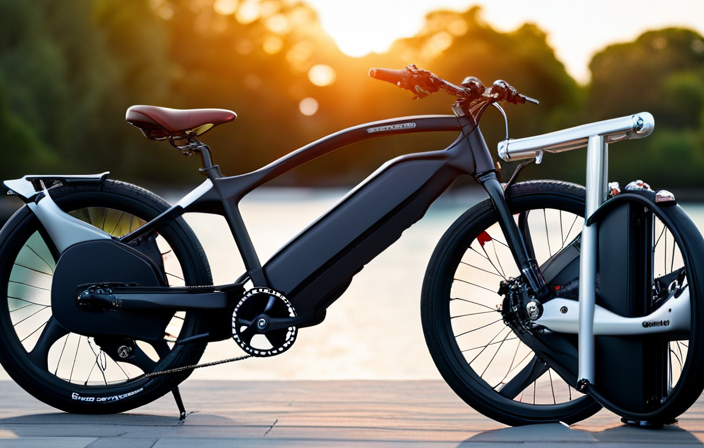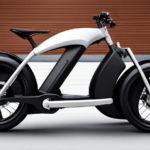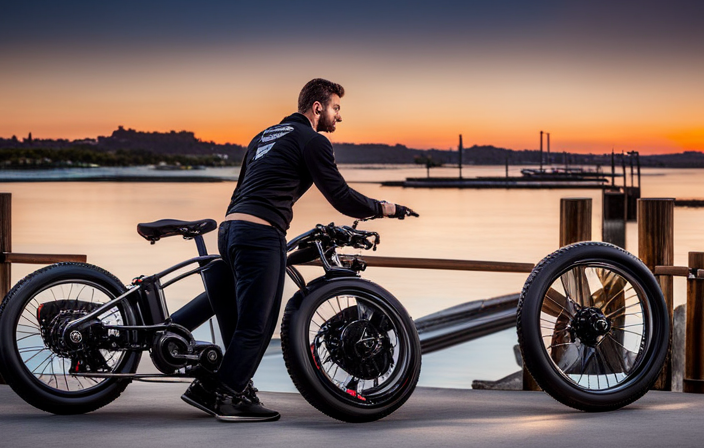As a passionate electric bike enthusiast, I understand the importance of choosing the right battery for optimal performance and longevity.
So, let’s dive into the world of electric bike batteries and discover the key factors to consider when making your purchase.
From understanding your bike’s requirements to evaluating capacity and compatibility, I’ll guide you through the process step by step.
By the end, you’ll be equipped with the knowledge to confidently select the perfect battery for your electric bike.
Let’s get started!
Key Takeaways
- Consider the voltage, capacity, and compatibility with your bike’s motor when purchasing an electric bike battery.
- Regularly charge the battery and avoid charging immediately after a ride to prevent capacity loss and protect battery lifespan.
- Store the battery in a cool, dry place to avoid damage, and avoid overcharging to prevent strain on the cells.
- Lithium-ion batteries offer high energy density and long lifespan, while lead-acid batteries are more affordable but heavier and less efficient.
Understand Your Electric Bike’s Battery Requirements
To understand your electric bike’s battery requirements, you’ll need to consider factors such as voltage, capacity, and compatibility with your bike’s motor. The battery is the heart of your electric bike, and proper maintenance is crucial for its longevity and performance.
Here are some battery maintenance tips to help extend its life.
Firstly, it’s essential to charge your battery regularly, even if you don’t use your electric bike frequently. Ideally, aim for a full charge at least once every month. This practice prevents the battery from losing its capacity over time. Additionally, avoid charging your battery immediately after a ride, as it may still be warm, which can reduce its overall lifespan.
Another important tip is to store your battery in a cool and dry place, away from extreme temperatures. Exposure to high heat or freezing cold can damage the battery cells and reduce their efficiency. Moreover, it’s crucial to avoid overcharging your battery. Once it reaches full capacity, unplug it from the charger to prevent unnecessary strain on the cells.
By following these battery maintenance tips, you can extend the life of your electric bike’s battery and ensure optimal performance.
Now, let’s move on to determining the type of battery you need for your electric bike.
Determine the Type of Battery You Need
First, figure out which type of battery suits your needs. When it comes to electric bike batteries, there are a few options to consider.
One popular type is the lithium-ion battery, known for its high energy density and long lifespan. These batteries are lightweight and provide excellent performance, making them a great choice for electric bike riders.
Another option is the lead-acid battery, which is more affordable but heavier and less efficient. It requires regular maintenance to ensure optimal performance.
Whichever type you choose, proper battery maintenance is crucial for longevity and efficiency. Regularly check the battery for any signs of damage or wear, and keep it clean and dry. Avoid extreme temperatures and store the battery in a cool, dry place when not in use. Additionally, consider investing in a battery management system to monitor and optimize the battery’s performance. By taking these steps, you can maximize battery efficiency and prolong its lifespan.
Now, let’s move on to the next consideration: battery capacity.
Consider the Battery Capacity
When it comes to choosing the right electric bike battery, two key factors to consider are range and mileage.
Range refers to how far the battery can take you on a single charge, while mileage refers to the distance you can travel before the battery needs to be recharged.
Another important aspect to look at is the voltage and amp hours of the battery.
Voltage determines the power output of the battery, while amp hours indicate how long the battery can provide that power before needing to be recharged.
Understanding these factors will help you make an informed decision when selecting a battery for your electric bike.
Range and Mileage
One important factor to consider when purchasing an electric bike battery is the range and mileage it can provide. Battery technology has come a long way in recent years, and different batteries offer varying ranges.
The range refers to the distance you can travel on a single charge, while mileage refers to the number of miles you can ride before the battery needs to be recharged. The battery range is influenced by various factors such as the battery capacity, the weight of the rider, the terrain, and the level of pedal assistance used.
It is essential to choose a battery with a range that suits your needs and riding style. By selecting a battery with an adequate range, you can enjoy longer rides without worrying about running out of power.
Now let’s delve into the next important aspect of electric bike batteries: voltage and amp hours.
Voltage and Amp Hours
The voltage and amp hours of an electric bike battery play a crucial role in determining its overall performance. When it comes to battery maintenance and longevity, it’s important to understand the significance of these factors. Here are a few key points to consider:
-
Voltage: Higher voltage batteries generally offer more power and acceleration, allowing for a faster and smoother ride. They also tend to have a longer lifespan and provide better overall performance.
-
Amp Hours: The amp hours (Ah) indicate the capacity of the battery to hold a charge. A higher Ah rating means the battery can provide more energy and support a longer ride.
Taking proper care of your battery is essential for maximizing its lifespan and performance. Regularly charging and discharging the battery, avoiding extreme temperatures, and storing it properly when not in use are all important factors to consider.
Now let’s move on to evaluating the battery’s voltage and compatibility with your electric bike.
Evaluate the Battery’s Voltage and Compatibility
To evaluate the battery’s voltage and compatibility, it’s important to check if it will work with your electric bike. The battery’s voltage determines the power it can deliver to the motor, while compatibility ensures that it can fit and connect properly to your bike’s electrical system. When assessing the battery’s voltage, consider the specific requirements of your electric bike. Some bikes may require a higher voltage to provide the necessary power for faster acceleration or uphill climbs. On the other hand, a lower voltage battery may be sufficient for casual rides on flat terrain.
In addition to voltage, you should also evaluate the battery’s compatibility with your electric bike’s charging system. This includes checking if the battery uses the same charging connector as your bike, as well as ensuring that the charging speed is compatible. The battery’s charging speed determines how quickly it can be recharged, and a higher charging speed can significantly reduce downtime between rides.
To help you analyze and compare different battery options, take a look at the table below:
| Battery | Voltage | Compatibility | Charging Speed |
|---|---|---|---|
| Option A | 48V | Compatible | Fast |
| Option B | 36V | Compatible | Moderate |
| Option C | 52V | Incompatible | Slow |
Assess the Battery’s Charging Time
Evaluating how quickly the battery can be recharged is essential in determining its charging time. When purchasing an electric bike battery, it is important to assess the battery’s charging time to ensure that it meets your needs. The charging time of a battery can vary depending on factors such as the battery’s capacity and the charger’s power output.
To assess the battery’s charging time, you can refer to the manufacturer’s specifications or consult with the seller. They should be able to provide you with information on how long it takes to fully charge the battery. It is also helpful to compare battery prices, as higher-priced batteries may offer faster charging times due to advanced technologies and higher-quality materials.
Additionally, when considering the battery’s charging time, it is important to also research the battery’s lifespan and durability. This will help you determine the overall value and longevity of the battery. By researching the battery’s lifespan and durability, you can make an informed decision and choose a battery that not only charges quickly but also lasts for a long time.
In the next section, we will explore how to research the battery’s lifespan and durability to ensure a wise investment.
Research the Battery’s Lifespan and Durability
Now that we have considered the battery’s charging time, let’s delve into another crucial aspect: the battery’s lifespan and durability.
When it comes to electric bike batteries, it is essential to research their lifespan and durability. After all, investing in a high-quality battery ensures a longer-lasting and more reliable riding experience. Here are three key factors to consider:
-
Battery Chemistry: Different battery chemistries have varying lifespans and environmental impacts. Lithium-ion batteries, for example, are commonly used in electric bikes due to their high energy density and long lifespan. They are also more environmentally friendly compared to other battery types, such as lead-acid batteries.
-
Battery Cycle Life: The battery’s cycle life refers to the number of complete charge and discharge cycles it can undergo before its capacity starts to degrade significantly. Look for batteries with a higher cycle life, as they will provide longer-lasting performance.
-
Performance in Extreme Weather Conditions: Consider how the battery performs in extreme weather conditions, such as extreme heat or cold. Some batteries may experience decreased performance or even damage in these conditions, so it is crucial to choose a battery that can withstand and perform well in the weather conditions you frequently encounter.
As we move forward in our quest to find the perfect electric bike battery, let’s now shift our focus to another important aspect: safety features.
Look for Safety Features
When considering which battery to choose, it’s important to look for safety features that can provide peace of mind while riding. Battery safety should be a top priority for any electric bike owner. Having the right safety features can greatly reduce the risk of accidents and ensure a smooth and worry-free ride.
One crucial safety feature to consider is overcharge protection. This feature prevents the battery from being overcharged, which can lead to overheating and potential fire hazards. Another important feature is short circuit protection, which safeguards against sudden surges in current that could damage the battery or even cause it to explode. Additionally, thermal protection is essential, as it helps regulate the battery’s temperature and prevents it from overheating during prolonged use.
To illustrate the importance of safety features, I have created a table that compares two batteries: one with advanced safety features and another without. Take a look:
| Safety Features | Battery A | Battery B |
|---|---|---|
| Overcharge Protection | Yes | No |
| Short Circuit Protection | Yes | No |
| Thermal Protection | Yes | No |
| Peace of Mind | High | Low |
| Risk of Accidents | Low | High |
As you can see, Battery A with its safety features provides high peace of mind and reduces the risk of accidents, while Battery B lacks these crucial safety measures.
Considering the weight and size of the battery is the next important factor to examine. The weight and size of the battery can affect the overall performance and maneuverability of your electric bike.
Consider the Weight and Size of the Battery
Considering the weight and size of the battery can greatly impact the overall performance and maneuverability of your e-bike. When it comes to electric bikes, weight plays a crucial role in determining how well the bike can perform. A heavier battery can negatively affect the bike’s speed, acceleration, and ability to climb hills. On the other hand, a lighter battery can enhance the bike’s performance and make it easier to handle.
Battery storage and transportation are also important factors to consider. You will need to find a battery that is easy to store and transport, especially if you plan on taking your e-bike on trips or commuting to work. Some batteries come with convenient carrying handles or straps, making it easier to transport them from one place to another. Additionally, consider the size of the battery and whether it will fit securely on your e-bike without hindering your comfort or balance.
When evaluating the brand and reputation of e-bike batteries, it’s important to consider their weight and performance capabilities. Look for brands that are known for producing high-quality batteries that are both lightweight and efficient. A reputable brand will provide you with a battery that offers excellent performance while being easy to handle and transport.
Transition: Now that we have considered the weight and size of the battery, let’s move on to evaluating the brand and reputation of e-bike batteries.
Evaluate the Brand and Reputation
A reputable and well-known brand will provide you with a battery that offers excellent performance while being easy to handle and transport. When evaluating the brand and reputation of a battery, it is important to consider a few key factors:
-
Quality and Reliability: A reputable brand will prioritize quality and reliability in their batteries. Look for brands that have a track record of producing durable and long-lasting batteries.
-
Technological Advancements: Compare battery technologies offered by different brands. Look for batteries that utilize advanced technologies such as lithium-ion or lithium polymer, as these tend to offer better performance and longer lifespan.
-
Warranty and Support: A trustworthy brand will stand behind their product with a solid warranty and excellent customer support. Consider the length and coverage of the warranty, as well as the responsiveness and helpfulness of the brand’s customer service team.
-
User Reviews and Ratings: Before making a final decision, it is always a good idea to read customer reviews and ratings. This will give you valuable insights into the real-world performance and satisfaction of the battery from actual users.
Read Customer Reviews and Ratings
Reading customer reviews and ratings can provide valuable insights into the overall satisfaction and performance of the battery. It’s essential to consider the experiences of other customers when buying an electric bike battery. These reviews can help gauge the level of customer satisfaction and determine the long-term reliability of the battery being considered.
By reading customer reviews, you can get a sense of how well the battery performs over time. Look for reviews that mention the battery’s durability and longevity. If multiple customers report that the battery consistently lasts for a long time and maintains its performance, it’s a good indication of its reliability.
Furthermore, customer reviews can provide insight into any potential issues or drawbacks of the battery. Look for reviews that mention any problems encountered, such as decreased battery life or difficulty in charging. By considering both positive and negative reviews, you can make a more informed decision about the battery’s overall quality and performance.
Now that you have gathered information from customer reviews and ratings, it’s time to compare prices and warranty options.
Compare Prices and Warranty Options
Now that you have the information from customer reviews and ratings, it’s time to compare prices and warranty options. When it comes to buying an electric bike battery, it’s important to consider these factors to ensure you get the best value for your money:
-
Price: Compare prices from different manufacturers and retailers to find the best deal. Keep in mind that higher prices don’t always guarantee better quality, so be sure to evaluate the features and specifications of each battery before making a decision.
-
Warranty: Look for batteries that come with a solid warranty. This is crucial because it ensures that you are protected in case of any manufacturing defects or issues with the battery. A longer warranty period usually indicates the manufacturer’s confidence in their product’s quality.
-
Battery Performance: Consider the battery’s capacity and range. Look for batteries with higher Wh (watt-hours) or Ah (ampere-hours) ratings, as they generally offer longer rides before needing a recharge. Additionally, check if the battery uses advanced battery technology, such as lithium-ion or lithium-polymer, which can provide better performance and durability.
When comparing prices and warranty options, it’s essential to also check for compatibility with your electric bike. This ensures that the battery will fit properly and work seamlessly with your bike’s system.
Check for Compatibility with Your Electric Bike
Make sure to check if the battery is compatible with your e-bike before making a purchase. Battery compatibility is crucial when it comes to electric bike specifications. Not all batteries are designed to work with every e-bike model, so it’s important to do your research and find a battery that is specifically made for your bike.
To determine compatibility, start by checking the voltage and capacity of your current battery. These specifications can usually be found in the user manual or on the battery itself. Once you have this information, look for a replacement battery that matches or exceeds these specifications. Make sure to consider the physical dimensions and mounting options as well, as the battery needs to fit securely on your bike.
If you’re unsure about compatibility, reach out to the manufacturer or a reputable e-bike retailer for assistance. They can help you find the right battery for your specific bike model. Additionally, some e-bike brands have proprietary battery systems, meaning you’ll need to purchase a battery directly from the manufacturer.
Consider Additional Accessories or Features
To enhance your riding experience, you might want to consider adding some accessories or features to your e-bike. These battery accessories and additional features can greatly improve the functionality and convenience of your electric bike. Here are four options to consider:
-
Battery Bag: A battery bag is a great accessory to have, as it provides a secure and convenient way to transport your e-bike battery. It protects the battery from damage and ensures that it stays in place during your rides.
-
Battery Charger: Having an extra battery charger can be extremely useful, especially if you plan on taking long rides or traveling to areas without easy access to electrical outlets. It allows you to charge your battery quickly and efficiently, ensuring that you have enough power for your journeys.
-
Display Console: Upgrading your e-bike with a display console can provide you with valuable information about your battery’s status, such as the remaining charge and distance traveled. It also allows you to adjust settings and monitor your speed, making your rides more enjoyable and efficient.
-
Lights: Adding lights to your e-bike can greatly enhance safety, especially when riding at night or in low light conditions. Front and rear lights not only make you more visible to other road users but also help you see the road ahead.
Considering these battery accessories and additional features can greatly improve your overall e-bike experience. And when you’re ready to make a purchase, it’s important to buy from a reliable retailer or manufacturer who can provide quality products and excellent customer service.
Purchase from a Reliable Retailer or Manufacturer
When purchasing from a reliable retailer or manufacturer, you want to ensure that they provide quality products and excellent customer service. This is especially important when buying electric bike batteries, as their reliability is crucial for the smooth functioning of your electric bike. To choose the right electric bike battery, there are a few tips to keep in mind.
Firstly, consider the battery’s capacity. The capacity is measured in watt-hours (Wh) and determines how much energy the battery can store. A higher capacity means longer riding distances. Additionally, pay attention to the voltage of the battery, as it should match the voltage requirement of your electric bike.
Next, check the battery’s chemistry. Lithium-ion batteries are the most common and offer a good balance between performance and weight. Other options include lead-acid and nickel-cadmium batteries, but they are heavier and have shorter lifespans.
Furthermore, consider the warranty provided by the retailer or manufacturer. A reliable seller will offer a warranty that ensures the longevity and reliability of the battery. It’s also worth reading customer reviews and ratings to gauge the satisfaction of previous buyers.
By purchasing from a reputable retailer or manufacturer, you can have peace of mind knowing that you are getting a quality product. This, combined with the right battery capacity, voltage, and chemistry, will ensure a reliable electric bike experience.
Now, let’s explore how to follow proper maintenance and charging guidelines for your electric bike battery.
Follow Proper Maintenance and Charging Guidelines
Following proper maintenance and charging guidelines for your e-bike battery is essential for ensuring its longevity and optimal performance. Here are three important tips to keep in mind:
-
Proper storage: When not in use, it’s important to store your e-bike battery in a cool and dry place. Extreme temperatures can degrade the battery’s performance and reduce its lifespan. Additionally, make sure to keep the battery away from direct sunlight and sources of heat, as this can cause damage.
-
Preventing overcharging: Overcharging your e-bike battery can lead to decreased performance and even permanent damage. To prevent this, it’s crucial to use a charger specifically designed for your battery model and to follow the manufacturer’s recommended charging time. Once your battery is fully charged, make sure to disconnect it from the charger to avoid overcharging.
-
Regular maintenance: To keep your e-bike battery in top condition, it’s important to regularly inspect and clean the terminals. Use a soft cloth or brush to remove any dirt or debris that may have accumulated. Additionally, make sure to check the battery’s voltage periodically and recharge it when necessary, following the proper charging guidelines mentioned above.
Frequently Asked Questions
Are there any safety features that I should look for in an electric bike battery?
When looking for an electric bike battery, it is important to consider safety features such as overcharging protection and short circuit prevention. Additionally, check for a battery with sufficient capacity and a reasonable charging time.
How important is the weight and size of the battery when considering which one to purchase?
When considering which electric bike battery to purchase, the weight and size are crucial factors. The battery’s weight affects the bike’s performance, and a heavier battery may decrease the overall range. It’s important to find a balance between battery range and weight for optimal performance.
What is the average lifespan of an electric bike battery?
The average lifespan of an electric bike battery depends on various factors such as usage, charging habits, and battery quality. Most electric bike batteries come with a warranty that typically ranges from 1 to 3 years.
How do I determine the compatibility of a battery with my electric bike?
To determine compatibility of a battery with your electric bike, check the battery voltage. For example, I once bought a battery with a higher voltage than my bike could handle, causing damage and disappointment.
Are there any additional accessories or features that I should consider when buying an electric bike battery?
When buying an electric bike battery, it’s important to consider additional accessories and features. Some key factors to look for are battery capacity, which determines the range, and charging time, which affects convenience and usability.
Conclusion
Well folks, that wraps up my comprehensive guide on buying an electric bike battery.
I hope you found it helpful and enlightening! Remember, when it comes to choosing the right battery for your bike, it’s crucial to understand your bike’s requirements, consider the type, capacity, voltage, and compatibility of the battery, and evaluate its charging time.
Don’t forget to purchase from a reliable retailer or manufacturer and follow proper maintenance and charging guidelines.
Now go out there and enjoy the ride, like a true electric bike aficionado!
















